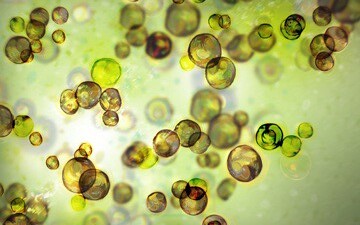Zooxanthellae (![]() /ˌzoʊ.əzænˈθɛliː/) are flagellate protozoa from the genus Symbiodinium that are golden-brown intracellular endosymbionts of various marine animals andprotozoa, especially anthozoans such as the scleractinian corals and the tropical sea anemone, Aiptasia.
/ˌzoʊ.əzænˈθɛliː/) are flagellate protozoa from the genus Symbiodinium that are golden-brown intracellular endosymbionts of various marine animals andprotozoa, especially anthozoans such as the scleractinian corals and the tropical sea anemone, Aiptasia.
Zooxanthellae live in other protozoa (foraminiferans and radiolarians) and in some invertebrates. Most are autotrophs and provide the host with energy in the form of translocated reduced carbon compounds, such as glucose, glycerol, and amino acids, which are the products of photosynthesis.[1] They can provide up to 90% of a coral’s energy requirements.[2] In return, the coral provides them with protection, shelter, nutrients (mostly waste material containing nitrogen and phosphorus) and a constant supply of carbon dioxide required for photosynthesis. Available nutrients, incident light, and expulsion of excess cells limit their population.
Hermatypic (reef-building) corals largely depend on zooxanthellae, which limits that coral’s growth to the photic zone. The symbiotic relationship enables corals’ success as reef-building organisms in tropical waters. However, under high environmental stress, corals die after losing their zooxanthellae either by expulsion or digestion, resulting in coral bleaching.
The coral and zooxanthella relationship has traditionally been considered mutualistic, that is, both partners benefit from the arrangement. However, whilst the benefit for the coral is clear in terms of its enhanced growth and calcification rate, the benefit for the algae has been called into question.[3]
Benefits cited for the algae include protection from predation and enhanced provision with chemicals such as carbon dioxide and ammonia.[3] However, a number of conditions are thought to be necessary to maintain a symbiotic relationship; on a very simple level, the symbiont’s optimal reproductive strategy must be to remain in the host. It is not clear whether these conditions are met in the coral-zooxanthella instance; reproduction of the zooxanthellae is retarded by almost two orders of magnitude when it dwells inside a coral.[3]
The relationship may be better thought of as a parasitic relationship, with the coral parasitic upon its enslaved algae. The coral ensnares the algae by secreting a chemical attractant, before ingesting the algae and incorporating them into its cells. They are then surrounded by a ‘symbiosome’ membrane and confined within the host cell, separated from its cytoplasm. The host cell then emits chemical signals that prevent the zooxanthella from reproducing.[3]
The presence of the alga results in the production of excess oxygen, which must be removed from the cell quickly to avoid destructive oxidation. The corals have mechanisms whereby they can kill overoxygenated cells if necessary.[3]
Coral bleaching occurs when zooxanthellae densities within coral tissue become low or the concentration of photosynthetic pigments within each zooxanthella decline. Color loss also comes from reduced concentrations of pigments produced by the cnidarian itself. The result is a ghostly white, calcareous skeleton. The coral will then die unless conditions improve enough to allow the zooxanthellae to return.
Zooxanthellae directly or indirectly experience the stress their containing corals undergo. Exposure to air during low tides and damage from solar radiation in shallow water environments are two of the ecological stressors coral and zooxanthellae face. Temperature changes now provide the most stress to the zooxanthellae-coral relationship. A one to two Celsius degree temperature rise for five to 10 weeks and a three to five degree decline for five to 10 days have produced coral bleaching events. Such temperature changes induce cell adhesion dysfunction which detaches zooxanthellae from their cnidarian endodermal cells.
(From Wikipedia, May 31st, 2012)




